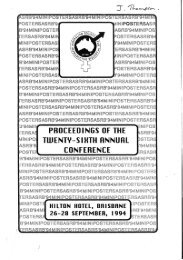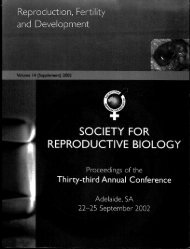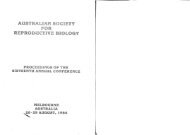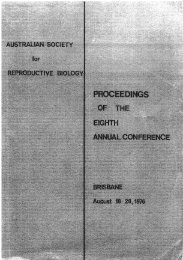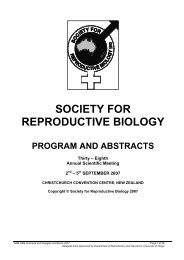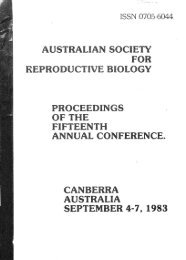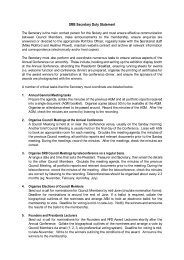ruoounu. nnSlunCIS&UINI-rOSIlnS - the Society for Reproductive ...
ruoounu. nnSlunCIS&UINI-rOSIlnS - the Society for Reproductive ...
ruoounu. nnSlunCIS&UINI-rOSIlnS - the Society for Reproductive ...
Create successful ePaper yourself
Turn your PDF publications into a flip-book with our unique Google optimized e-Paper software.
FSA FREE COMMUNICATIONS-SPERM AND EMBRYOSFSA FREE COMMUNICATIONS-SPERM AND EMBRY~'ANALYSIS OF ANEUPLOIDY IN EMBRYOS FROM 53 IVF PATIENTS WITHPOOR PROGNOSIS OF PREGNANCYL. R. Gras \ G. M. Jones 2, A. P. Kausche 2 and A. O. Trounson 21. Monash IVF, 252 Clayton Rd., Clayton, Victoria, 31682. Monash Institute ofReproduction and Development, Monash University, Clayton, Victoria, 3168IntroductionNumeri~al chr~mosome abno~alityrates of57% have previously been reported in morphologicallynormal embryos fromIVF patIents wIth poor progn~~lSofpregnancy (i.e. ~ 37 years ofage, repeated IVF failures and/or altered karyotype) (1).T~ese chromosome abnorm~htl~s have been postulated as a possible cause ofpoor embryo viability, resulting in IVFfallures ~he~ embry~ selectIOn.1S based purely on morphological criteria. Selection ofchromosomally normal embryos <strong>for</strong>transfer slgmfica?tly l~cr~ased Implantati~n rates. Comparison ofembryo morphology and corresponding aneuploidydemonstrated a higher l~cldence ~fnumencal chromosome abnormalities in both slower (5-6 cell, 61% aneuploidy) andaccelerated.(>8 c~ll, :6Yo aneUplOI?y) c!eavage stage embryos, than in embryos at <strong>the</strong> 7-8 cell stage (42% aneuploidy) onday 3 po~t-InsemmatlOn (1)..IdentlficatIOn ofembryos that possess a greater potential to develop to term is beneficial inIVF, pa~tlcularly when selectmg <strong>for</strong>transfer from a large cohort ofembryos. Parameters likely to reflect increased risk ofaneuplOIdy, and hence reduced embryo viability are <strong>the</strong>re<strong>for</strong>e advantageous.Materials and MethodAneuploidy was investigated i~ a group of53 IVF patients with poor prognosis ofpregnancy. Embryo biopsy wasperf~rr.ne~on day 3 embryos WIth ~ 5 cells, by laser zona drilling, removal of 1-2 blastomeres and fluorescent in situhybndl~atlOn (FISH) analysis <strong>for</strong> chromosomes X, Y, 13, 18 and 21 (25 patients) and in addition, chromosomes 16 and 22(28 patIents).ResultsA total of.3 62 em~ryos were biopsied. FISH analysis was possible from 314 embryos (87%), resulting in identification of158 euplOId (50.3 Ya) ~d.15? ane~ploid (~9.7%) embryos. No FISH result was obtained from 48 embryos (blastomeres~ere anucleate or hybndlsatlOn faded). SIxty-five aneuploidies involved single monosomies or trisomies (41.7%), 81Involved ~o:e than one chromosome error (51.9018cell) embryo~ was 54.3 Ya, however thIS was not slgmficantly greater than in 7-8 cell embryos (P>0.05). Aneuploidy inslower cle~vmg embryos (5-6 cell) was 61% when associated with high (>113) fragmentation and 55.7% with little or nofragmentatIOn (P>0.05). More ~lastomer~~biopsied from 5-6 cell embryos were considered anucleate (14/129, 10.9%) thanfrom !-8 cell embryos (7/176, 4Ya). AddltlOnaIIy, of17 biopsied muitinuceated blastomeres, only 4 were found to beeuplOId. .Trans~er ofa total of 118 embryos identified as normal <strong>for</strong> <strong>the</strong> chromosomes tested resulted in 7 ongoingpregnancIes, WIth a pregnancy rate of 14% and implantation rate of6%.ConclusionWe confi:~ that embtyos from patients with poor prognosis ofpregnancy have a high incidence ofchromosome numericalab~ormahtles. EXclu~lOn from tr~sfer of cI:r0mos?~llyabnormal embryos has <strong>the</strong> potential to improve prognosis in <strong>the</strong>sepatIents. MorphologIc~1 obs~rv~tlOns co~bmed WIth In<strong>for</strong>mation derived from preimplantation diagnosis provides fur<strong>the</strong>rvaluable embryo sel~ctlOn cn!ena. SelectlOn <strong>for</strong> transfer ofgood quality 7-8 cell embryos on day 3 in preference to thosethat are slower cleavmg, may mcrease chance ofchromosome normality and<strong>the</strong>re<strong>for</strong>e improve implantation potential.EXPERIENCE WITH THE INTRODUCTION OF A COMPREHENSIVEPREIMPLANTATION DIAGNOSTIC SERVICE FOR SERIOUS GENETIC DISEASEMcArthur, S.J., de Boer, K.A., Leigh, D., Roberts, C.G., Catt, J.W., Bowman, M.C., Persson, J.A., Anderson,J.C., and Jansen, R.P.S.Sydney IVF, Sydney, NSW 2000.Introduction. In <strong>the</strong> 1990s Sydney IVF considered that a comprehensive preimplantation genetic (PGD) service wouldrequire optimum laboratory practices in <strong>the</strong> o<strong>the</strong>rwise different fields ofin vitro fertilization (including embryo culture to atleast <strong>the</strong> morula stage to permit transfer ofmetabolically uncompromised embryos after biopsy), cytogenetics with rapiddetection ofchromosomes using fluorescent in-situ hybridization (FISH - <strong>for</strong> rapid identification ofcertain autosomes and<strong>the</strong> sex chromosomes in removed blastomeres and/or polar bodies) and accurate polymerase chain reaction (PCR)techniques with reliable products derived from singles copies ofDNA. There<strong>for</strong>e, be<strong>for</strong>e <strong>the</strong> introduction ofPGD, threedistinct service were developed to functional efficiency, after which <strong>the</strong>y were integrated to comprise <strong>the</strong> PGD project.Methods. Development ofstage specific culture medium and optimum embryo culture methods have been describedpreviouslyl. The PGD laboratory team was integrated with <strong>the</strong> clinical genetics team to consider each couples PGDrequirements. Pregnancies followed <strong>the</strong> abandonment ofacid Tyrode's <strong>for</strong> opening of<strong>the</strong> zona pellucida and <strong>the</strong> useinstead ofa FERTILASE® near infrared laser. As well as <strong>for</strong> avoiding sex-linked genetic disease, IVF with selection ofembryos on <strong>the</strong> basis ofsex and apparent euploidy has, <strong>for</strong> some families, been <strong>for</strong> <strong>the</strong> (non-HIC-rebated) purpose ofaddinga child of<strong>the</strong> o<strong>the</strong>r sex to existing children.Results.PGD ResultsOverall AssistedConception results atSIVF,1998Overall PGD Sex Selection Genetic PGD



